- Joined
- Oct 17, 2018
- Messages
- 966
I just bought a Craftsman 101.07403 lathe. It is in dire need of taking apart, cleaning and lubing. I have some questions:
1. The spindle bearing might be shot. It turns by hand but feels "crunchy" (I believe that is the proper technical term). Could need replacing. How do I get it out to tell? I may try putting some oil in the cups in the meantime. I'd like details, not just "pull them out". I've never done it, so I need pictures or links to how to do it. Whatever ya got!
2. What oil/lube/grease do I use for lubing the various parts? Is there a table or list somewhere? I couldn't find a manual, just a parts list.
3. What should I clean this with? I'm thinking Simple Green and rags. Lots of rags. Can I use a wire brush, and should it be steel, brass, plastic or bristle? Can I use a wire wheel on a drill or should this be done by hand? Can I soak the rusty bits in Evapo-Rust? What do I use to clean the "varnish" off? I've seen references to "varnish" several times, and am wondering exactly what that is referring to? Dried up oil on the ways?
4. Is the original paint on this baked on or sprayed on? My lathe has what appears to be paint spill/spatter on it (white dots in the pictures). The original paint is in pretty good shape, so I don't want to mess it up.
5. Is the spindle threaded on with a reverse thread? Mine is stuck on really good. After I spray Liquid Wrench on the thread I want to make sure I'm rotating the spindle in the correct direction. And, what kind of tool can I use to get some leverage? There are no flats on the spindle that could grip a wrench. And if the gear that engages the spindle lock is Zamak, I don't want to break it.
6. Can someone direct me to pictures of what the lathe looked like new so I can see if I'm missing any knobs, ID plates, etc? I think there is a knob missing on the cross slide. Or, just tell me.
7. When referring to my lathe what is the proper way: 101.07403, 101-07403 101 07403 or does it matter?
If you like, just list the number and your answer, especially if you only answer one or a few of the questions.
Some pictures for reference:
BACK I took the motor off to make it lighter to unload.
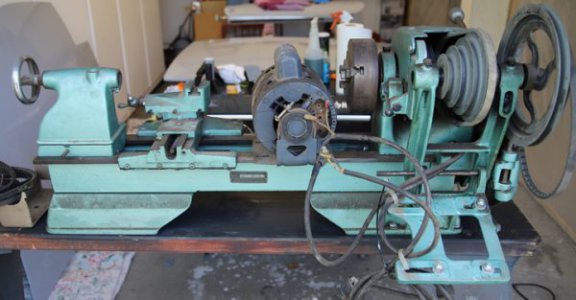
FRONT I took the motor off to make it lighter to unload.
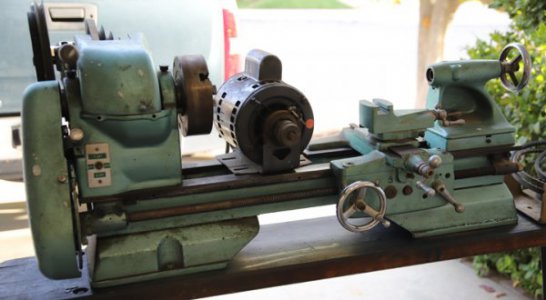
GEARBOX
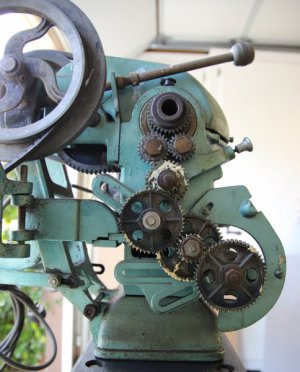
CARRIAGE I seem to be missing a knob.
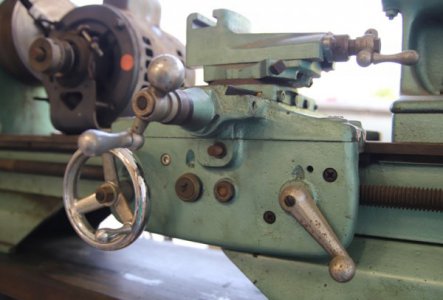
CROSS SLIDE
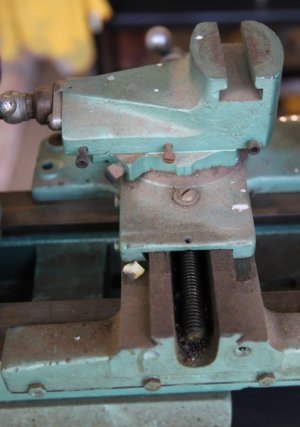
CHUCK
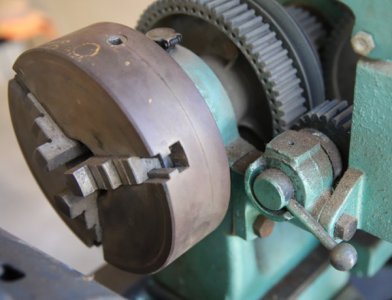
DRIVE
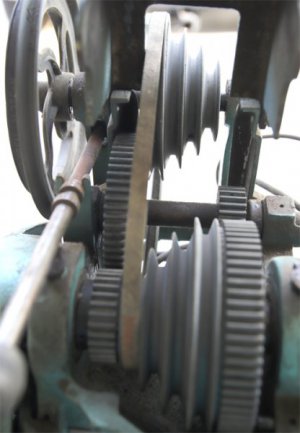
1. The spindle bearing might be shot. It turns by hand but feels "crunchy" (I believe that is the proper technical term). Could need replacing. How do I get it out to tell? I may try putting some oil in the cups in the meantime. I'd like details, not just "pull them out". I've never done it, so I need pictures or links to how to do it. Whatever ya got!
2. What oil/lube/grease do I use for lubing the various parts? Is there a table or list somewhere? I couldn't find a manual, just a parts list.
3. What should I clean this with? I'm thinking Simple Green and rags. Lots of rags. Can I use a wire brush, and should it be steel, brass, plastic or bristle? Can I use a wire wheel on a drill or should this be done by hand? Can I soak the rusty bits in Evapo-Rust? What do I use to clean the "varnish" off? I've seen references to "varnish" several times, and am wondering exactly what that is referring to? Dried up oil on the ways?
4. Is the original paint on this baked on or sprayed on? My lathe has what appears to be paint spill/spatter on it (white dots in the pictures). The original paint is in pretty good shape, so I don't want to mess it up.
5. Is the spindle threaded on with a reverse thread? Mine is stuck on really good. After I spray Liquid Wrench on the thread I want to make sure I'm rotating the spindle in the correct direction. And, what kind of tool can I use to get some leverage? There are no flats on the spindle that could grip a wrench. And if the gear that engages the spindle lock is Zamak, I don't want to break it.
6. Can someone direct me to pictures of what the lathe looked like new so I can see if I'm missing any knobs, ID plates, etc? I think there is a knob missing on the cross slide. Or, just tell me.
7. When referring to my lathe what is the proper way: 101.07403, 101-07403 101 07403 or does it matter?
If you like, just list the number and your answer, especially if you only answer one or a few of the questions.
Some pictures for reference:
BACK I took the motor off to make it lighter to unload.

FRONT I took the motor off to make it lighter to unload.

GEARBOX

CARRIAGE I seem to be missing a knob.

CROSS SLIDE

CHUCK

DRIVE

